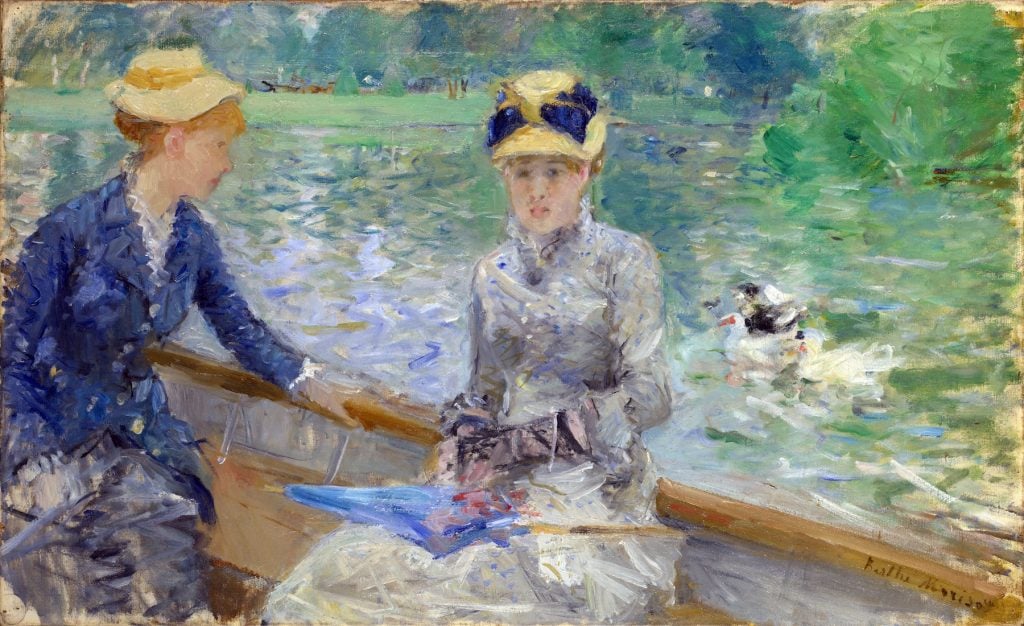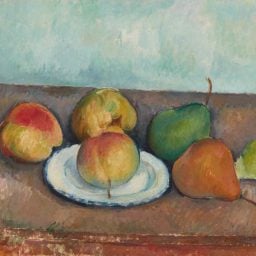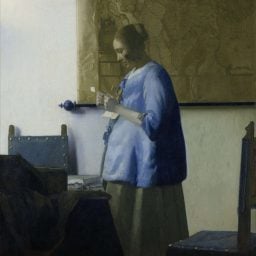The last days of summer often arrive with a hint of melancholy, and maybe a twinge of anxiety.
Berthe Morisot, one of the Impressionist movement’s few well-known women artists, had a particular gift for capturing the complexity of her figures’ interior experiences—often while they’re in seemingly jovial circumstances.
Compared to Monet’s sun-dappled cliffs and Renoir’s festive gatherings (the Impressionists certainly loved summer), Morisot’s Summer’s Day (Jour d’eté) (1879) stands as a more emotionally nuanced seasonal counterpoint.

Édouard Manet, Berthe Morisot with a Bouquet of Violets (1872). Collection of Musée d’Orsay.
In Summer’s Day, two ladies done up in the latest fashions are pictured seated in a rowboat floating in a lake of shimmering dabs of green and blue. The paintings was made at the Bois de Boulogne, a public park in the 16th arrondissement in Paris, a favorite place of Morisot’s, and close to her apartment and studio.
One woman, clad in a bright blue jacket and a straw bonnet, looks out toward the water. The other, adorned in a glimmering ensemble of lavenders and whites, sits with her hands clasped, a parasol on her lap, and glances out from the canvas toward the viewer. The image has a feeling of unposed spontaneity, and despite the picturesque setting, there’s a slightly anxious sense to Morisot’s ode to summer.
As August winds to a close, we’ve decided to take a closer look at Summer’s Day. Here are three surprising facts that will further illuminate the summer scene.
The Blues and Yellows Were Unusual for the Time
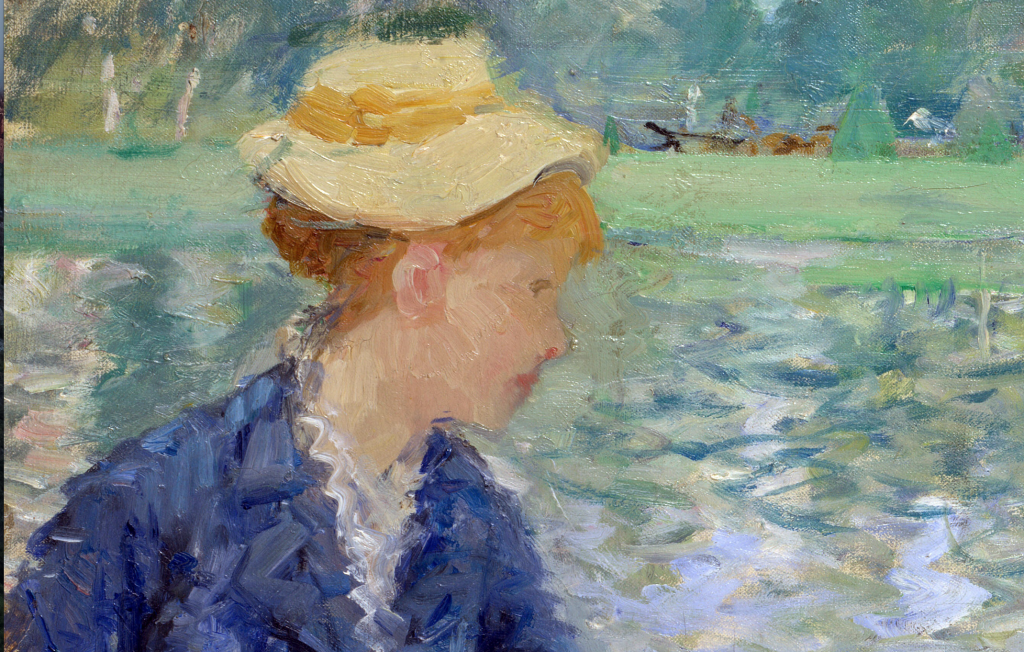
Morisot’s inclusions of cerulean blue, cadmium yellow, and any earth tones would have been unusual at the time.
Vigorous dashes of color form an energetic pattern that moves the eye across the canvas in a way that mimics the movement of water. Though one might not realize it today, the color palette for Summer’s Day was somewhat unusual for its time.
In the mid-1800s, tubed paints were only just becoming available—a product development that allowed for artists like the Impressionists to paint outside of their studios. But many of the colors used today were simply not widely available. For instance, the cerulean blue that Morisot uses in passages of the turned figure’s coat was only introduced as a pigment in the 1860s. And while Monet added the hue to the sky of his La Gare Saint-Lazare (1877), and Manet to his Corner of a Café-Concert (1878), cerulean was still a visual novelty, as was the cadmium yellow used in parts of the women’s hats.
What’s more, the earth tones that Morisot adds here and there were totally out of vogue with the Impressionists. Camille Pissarro had gone so far as to say he had banished the old-fashioned seeming hues from his palette. Some of Morisot’s distinctive palette choices are likely the lingering tutelage of her first instructor, Jean-Baptiste-Camille Corot—namely in her love of whites, silvery lavenders, and vibrant greens. Though not as apparent as in some canvases, a close look at the main figure’s dress here reveals the varied tones of white that Morisot often employed, and which can sometimes seem directly plucked from Corot’s skies.
These hues, Morisot applied in a feathery, zigzag that forced one hue to collide into the next. “She gives the finishing touch to her canvases by adding slight brush strokes here and there—it is as if she were shedding flowers,” the 19th-century art critic Theodore Duret famously mused of her process.
Morisot Would Have Stood Out as a Woman Painting in Public
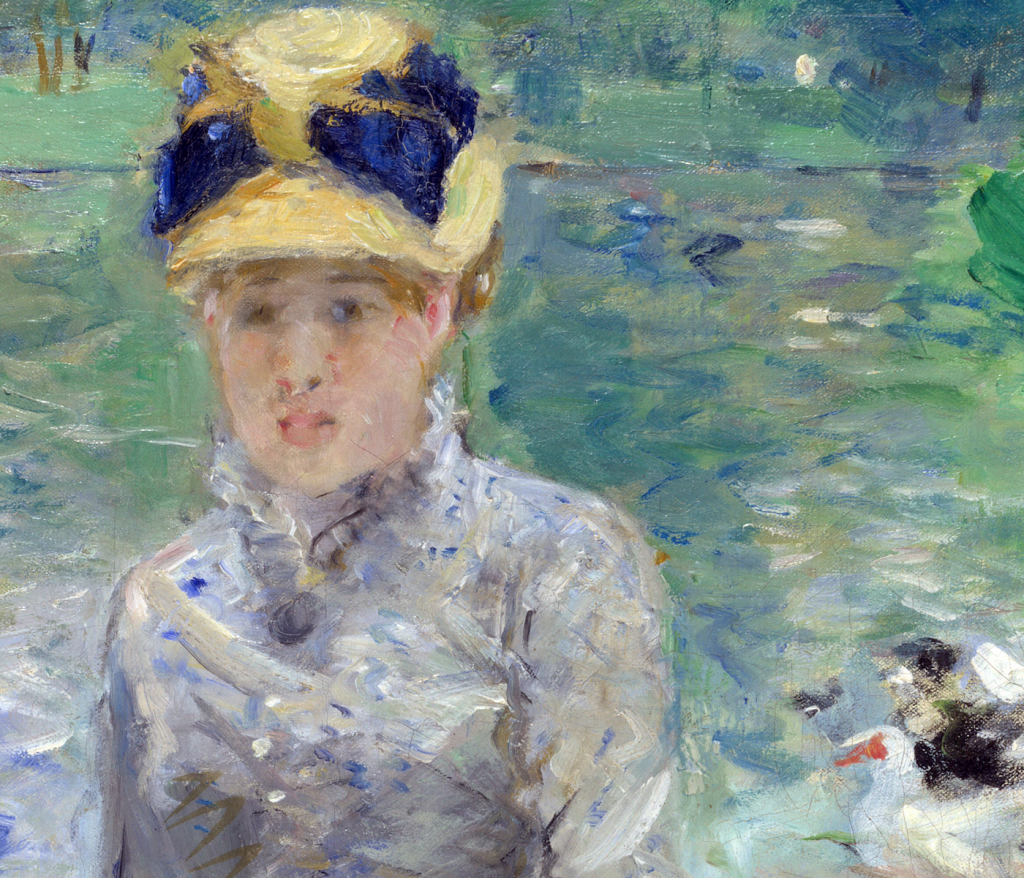
Detail of Summer’s Day. Collection of the National Portrait Gallery London.
In recent years, Morisot has enjoyed something of an art historical retrieval from obscurity. In particular, “Berthe Morisot: Woman Impressionist,” an exhibition at the Barnes Foundation in Philadelphia in 2018, showcased the dazzling breadth of a career cut short by the artist’s death from pneumonia at the age of 51. But the show also showcased just what Morisot was up against as a woman painter of the age, even as an unusually privileged woman of the era.
Morisot’s upper-middle-class parents encouraged the talents of both her and her sister Edma (her mother was a descendent of the Rococo artist Jean-Honore Fragonard)—securing lessons for both daughters from a young age. Morisot, who was introduced to Impressionism by Edouard Manet, would go one to marry his brother Eugène, a painter who would give up his career to support hers, even after the birth of their daughter, Julie.
Despite these luxuries, Morisot’s oeuvre, like that of Mary Cassatt, is weighted heavily toward the lives of women in the domestic sphere—probably for practical purposes. “Morisot painted outdoors when she could, a dicey practice at a time when respectable, unaccompanied women passed their lives under what amounted to house arrest—she was liable to be stared at by passersby and flocked by children,” Peter Schjeldahl explained in his review of the Barnes exhibition in the New Yorker.
Summer’s Day is unique in that it is one of a limited number of paintings that Morisot completed en plein air. With this in mind, it can be viewed through the lens of Morisot’s own experience. One can imagine the scene of Morisot painting the women (they were likely hired models) and the peculiarity of that observation. In that sense, the anxious but confronting gaze of the woman in lavender seems to take on a powerful new meaning.
It Endured a 100-Year Battle for Ownership

Paul Hogan leaving the Tate with the stolen artwork under his arm, April 14, 1956. Courtesy of Keith Farrell/Getty Images.
Ownership of Morisot’s masterpiece was hotly contested for over a century, with both the National Gallery of London and the city of Dublin claiming rights to it. So why the hundred years’ war, you ask?
The story centers around the dying wishes of Hugh Lane, a turn-of-the-century Irish art dealer and collector, and painting’s former owner. Lane was an advocate for Irish art abroad and one of the foremost collectors of French Impressionism of the age. Having grown frustrated by a series of setbacks while running his gallery in Dublin, the collector decided to bequeath his trove of 39 paintings, including Summer’s Day, to the National Gallery in London, rather than to his homeland.
In 1915, Lane was killed in the sinking of the Lusitania, and his paintings were thereafter sent to London. But, in an operatic twist, it would soon come to light that Lane had actually added a codicil (though unwitnessed) to his will that shifted ownership of the paintings to the city of Dublin—a revelation that the National Gallery refused to acknowledge. An international hubbub set off with even the likes of WB Yeats campaigning for the return of the paintings to Ireland.
Despite patchwork arrangements to share ownership of the paintings between the cities, the “Hugh Lane Bequest,” as it came to be known, remained a heated point of debate. In 1956, Summer’s Day took a starring role in the controversy, when two Irish students, Paul Hogan and Billy Fogarty, took it upon themselves to snap the painting from its display at the Tate to highlight Ireland’s claim to the paintings. The audacious young pair even arranged for a press photographer to capture the moment when Hogan would walk out from the museum with the painting tucked under his arm. The plan went off without a hitch on April 14, 1956. The one exception being that the duo hadn’t really decided what they would do with the painting once they’d snatched it.
Ultimately, they wound up leaving the painting at the Irish embassy anonymously. London police decided not to charge the pair worrying they could become Irish political heroes and, too, that a trial would reveal the museum’s shabby security. The final fate of the trove of paintings—and Summer’s Day—remains unresolved to this day.
